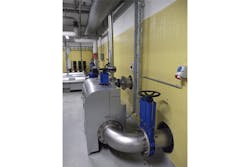A wastewater treatment plant that serves the western side of Aalborg in Denmark replaced an ineffective mixer which led to a healthy chain of significant process improvements — including a more than 20 percent increase in gas.
Serving a population of 120,000, the plant’s operators wanted to reduce solids by finding a more efficient way to mix the contents of a pretreatment tank for its sludge digesters. According to Aksel Nielsen from Aalborg Forsyning, Kloak A/S (the wastewater utility), over time, less and less sludge passed through with the old system. The operators were using higher pumping pressures.
Eventually the facility had to bypass the heat exchangers, using more energy for its processes. For this reason, the facility sought a new mixing technology to stabilize the sludge flow.
The new technology
The equipment causing a stir was a new externally mounted mixer made up of chopper pumps and a self-aspirating system that reduces solids.
"To be honest, I was on the phone a couple days after the installation," says Nielsen, "because it seemed as if something was wrong. There was a problem, but only because the mixing was so good. Everything, absolutely everything, had come to the surface. All the sediment that had built up in the corners of the tank was back in play. This was surprising and impressive because our enclosed tank is far from a standard size, including different depths. [Before the new mixer], we thought comprehensive mixing of the sludge in this tank was beyond the capability of mixers."
The results
With the new mixer, flow has increased from the high-pressure pump application from 10 cubic meters per liter (m3/l) to 16 m3/l (6 bar). With more broken down sludge entering the system, 318 m3/l of gas is being produced, compared to the previous average of 250 m3/l.
"The main purpose was to try and stir everything up better for the benefit of the whole process," explains Nielsen. "Our objective was not for a new mixer to try and make gas or to try to improve the gas [production], yet the new mixer is actually producing more than 20 percent more gas than we had before."
Three 250-kilowatt gas engines produce 5 megawatts, enough to power almost the entire plant and dry the final sludge, with residual heat for the plant.
"Effectively, we’re now pumping much larger volumes for a much lower price," says Nielsen. "The cutting knife-system of the chopper pump continually breaks up solids (around 6 percent), so everything is far more fluid and easier to pump. The reduction in particle size is consistent, which is a big benefit to our work."
The heat exchangers are in full operation and more efficient. Despite the enhancement in mixing, the new system operates for approximately 5 minutes on, 45 minutes off. The previous mixers operated 24 hours per day every day of the week.
Reliability also reduced service from quarterly to once per year. The externally mounted design makes maintenance and other service quicker.
In addition, the curse of struvite (magnesium ammonium phosphate) has reduced. The release of ammonium and phosphate from the wastewater treatment, particularly after the digesters, required that the pipework be cleaned every 14 days. This has been reduced to every two months at most.
Nielsen concludes, "A mixer will always manage to achieve some sort of mixing results, but we can see quite conclusively that [the new system] is truly mixing the whole tank."
Image courtesy of Landia Inc.
Based in Cary, North Carolina, Soren Rasmussen is the director of Landia Inc., the U.S. subsidiary of Landia A/S in Denmark. Rasmussen spearheads Landia’s share of the North American market, where it serves biogas, municipal and other industrial applications.

